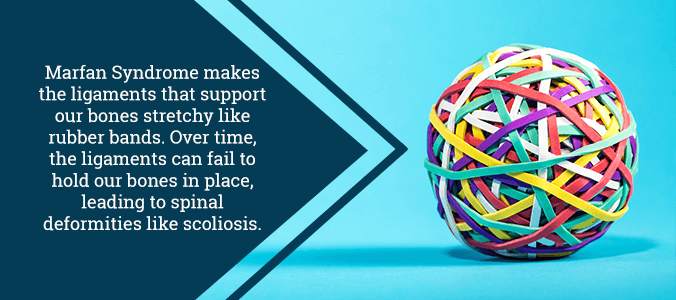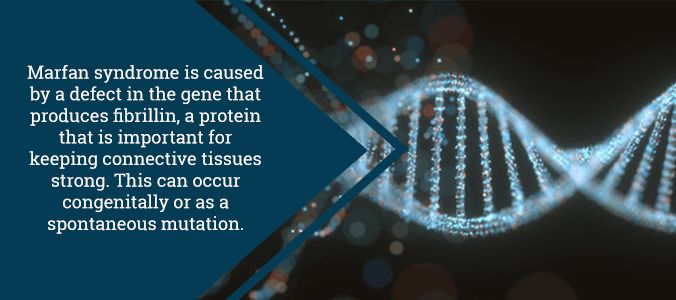Scoliosis in Children with Marfan Syndrome
Marfan syndrome causes characteristic problems to arise in the bones and joints, which leads patients and doctors alike to suspect the condition. These skeletal features occur when the bones grow too long or the ligaments stretch out beyond what doctors consider normal.
Likewise, there is a slew of skeletal features such as these that Marfan syndrome can cause. In fact, many patients with Marfan syndrome have more than one of these features. That being said, hardly anyone has every single feature at the same time. Therefore, it is important to contact an orthopedist to evaluate your condition. However, it should be understood that only a third of people with this disorder require treatment for skeletal deformities.

What is Marfan Syndrome?
Commonly, characteristics of Marfan Syndrome include being thin and tall, as well as having unusually long fingers and arms. In addition, many people who suffer from Marfan syndrome are nearsighted. But, of course, the condition affects everyone differently. Children with Marfan Syndrome may display a long list of symptoms or they may exhibit only a few. On top of this, these symptoms can range from mild to severe.
Blood Vessels & the Heart
Cardiovascular issues are very common in patients with Marfan Syndrome. One of the most severe problems involves the aorta, where weakened connective tissue can lead to arterial enlargement. An enlarged aorta is prone to tearing and leaking blood, which is extremely dangerous and may require immediate surgical attention.
Other problems associated with the condition include mitral valve prolapse, pulmonary artery dilation, and left ventricle dilation.
Treatments for these symptoms include medications such as beta-blockers and blood pressure medicines. Usually, your doctor will detect these symptoms on heart monitoring tests, such as an echocardiogram.
Scoliosis (Curvature of the Spine)
Scoliosis describes a condition in which the spine curves off to one side. Usually, the vertebrae twist, causing the spine to adopt an S-shape or spiral. This may occur at any level of the spine, but typically, it occurs in the cervical spine. Roughly 60% of people with Marfan Syndrome have scoliosis; however, only 33.3% require medical treatment for it.
When ligaments in the spine become so loose that they can no longer secure the vertebrae, it leads to scoliosis. In children experiencing rapid growth and Marfan Syndrome, scoliosis curves are likely to exaggerate even more. This usually happens during the patient’s teenage years, as that is when one of the biggest growth spurts occurs.
Scoliosis may be mild or it may be severe. It all depends on the degree of curvature. Doctors base this grading on the angle between the vertebrae measured as a number or in degrees. A small curve of fewer than 20 degrees in a child has a low risk of getting worse. Moderate curves between 20-40 degrees have a greater chance of worsening, while severe curves of more than 40 degrees will almost assuredly exacerbate. This is true for both children and adults. Naturally, this boils down to the cause and effect of gravity and its bearings on the spine.
Children are commonly checked for scoliosis in the fifth grade, however, patients with Marfan syndrome should be checked for the condition even before this time. A doctor will perform this exam by having the child bend forward upon to reveal the curvature of the spine. If the child has not developed scoliotic curves by middle school, it is unlikely that he or she will develop the condition later in life. Scoliosis rarely begins during adulthood. It is almost always a pre-existing condition before that time.

Marfan Syndrome: Bones & Joints
Some of the most obvious signs of Marfan Syndrome involve the bones and joints. Weakened connective tissue causes bones to grow more quickly than they usually should. Additionally, the condition affects ligament tissues, making it looser. Of course, this is not a good thing as ligaments are responsible for holding the bones together and keeping our joints stable.
Patients with Marfan Syndrome may exhibit any number of the following skeletal features:
- Tall stature & thin body
- Unusually long extremities
- Extra lengthy fingers
- Breastbone curvature
- Scoliosis
- Loose, flexible ligaments
- High arch in the roof of the mouth
- Crowded teeth
- Low bone density
- Deep hip sockets
Of course, symptoms of the condition do not end here. Marfan syndrome may also cause the membranes that surround the brain and spinal cord to swell. This is otherwise known as dural ectasia, and many patients with Marfan syndrome have this symptom. This may lead to lower back pain, leg pain, abdominal pain, and headaches.
Patients with Marfan syndrome are also more likely to experience breathing problems. Usually, deformities in the breastbone are what leads to this kind of symptom. Deformities of the spine, in general, are also known to cause similar problems. Likewise, lung collapse is more likely to occur in patients with this condition.
Marfan Syndrome Causes
Marfan Syndrome is directly caused by genetic defects in fibrillin—a protein in the body that is important for keeping connective tissues strong. Most people with Marfan syndrome inherit this gene from a parent who already has the condition. However, one-fourth of cases occur from a spontaneous defect in the fibrillin gene.
Patients with Marfan Syndrome have a 1 in 2 chance of passing the disorder along to their kids. And, Marfan Syndrome occurs equally in both genders.

Marfan Syndrome Treatment
There is no cure for Marfan syndrome. Treatment focuses mainly on managing symptoms and preventing the condition from worsening. In most cases, the condition exacerbates with age.
Many different types of medical specialists will have their hand in treating a patient with Marfan Syndrome. The type of specialist seen will naturally depend on the range of symptoms a patient has. Treatment may be provided by a cardiologist, an eye doctor, or an orthopedic surgeon. However, because the range of symptoms varies so wildly, it is not uncommon to need the expertise of more than one of these specialists.
Scoliosis Treatment
Many cases of scoliosis do not require treatment. That being said, patients with more severe curves may require surgery or bracing.
Roughly 6 out of 10 children with Marfan syndrome have scoliosis. That being said, most of these cases involve spinal curves that are too small or mild to require treatment.
If you or your child does require treatment for Marfan Syndrome, you may expect the following methods:
- Bracing: If the patient has a curve of 15 to 25 degrees—especially if the curve is worsening—your doctor may recommend bracing. It is important to understand that this treatment does not straighten scoliotic curves. Instead, it simply prevents them from worsening. Unfortunately, bracing has been demonstrated to be less impactful in children with Marfan Syndrome than it is in children with idiopathic scoliosis. This only becomes even more evident with larger scoliotic curves.
- Spinal Fusion: In cases where curves are more severe, your doctor may recommend corrective surgery over more conservative methods. Spinal fusion is more or less a welding process. The idea is to fuse together affected vertebrae so that they heal into a single bone. Additional hardware such as screws, rods, hooks, or wires may be used to hold the bones in place while fusion occurs.
- Other Conservative Options: Of course, conservative options do not stop at bracing. Depending on the patient’s range of symptoms, other more conservative methods may prove to be just as effective. This includes over-the-counter medication, epidural/nerve block injections, and physical therapy.
Contact Us
Do you or your child have any of the conditions mentioned above? If so, please contact us at (855) 220-5966. Dr. Jason E. Lowenstein is a leading expert in both scoliosis and general spinal deformity care. Dr. Lowenstein will ensure that you will be put on a care plan that is tailored to meet your specific needs. Contact us today.
